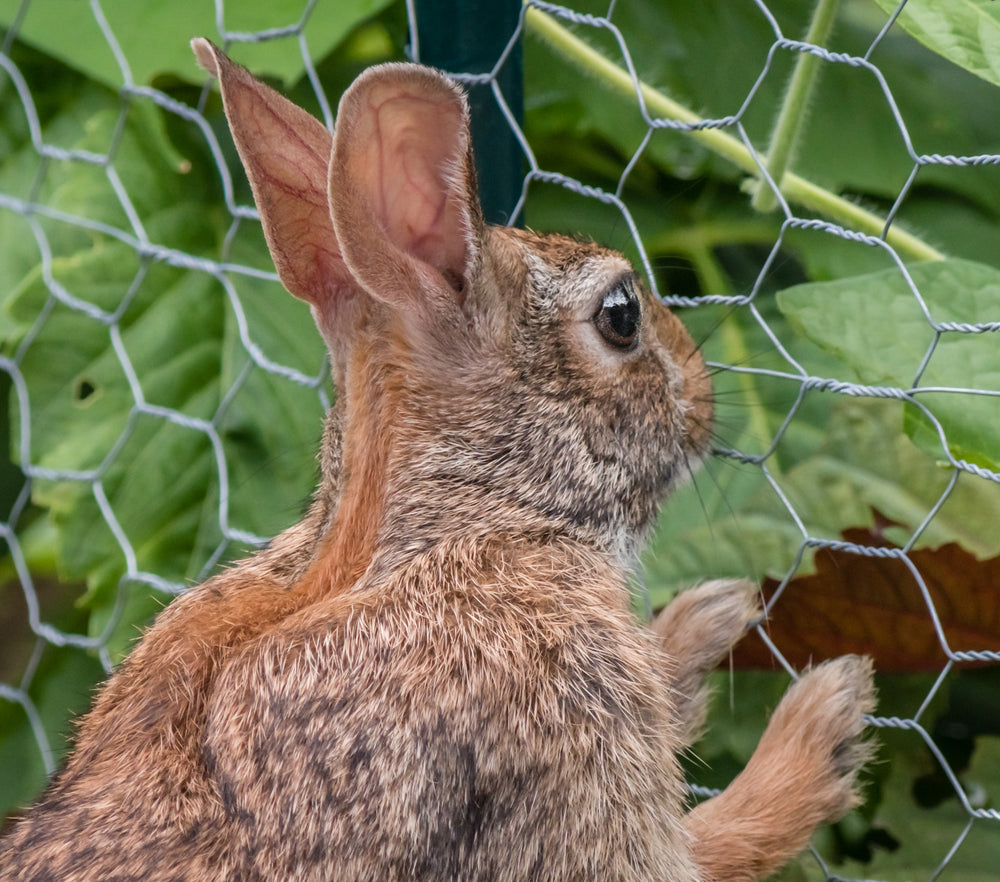Forget the fact that rabbits are soft, fuzzy, and cute. These critters can be one of a gardener's most despised pests, wiping out entire crops overnight. Rabbits prefer young, tender shoots and are particularly fond of lettuce, beans, and broccoli. Flowers they like to nibble include gazanias, marigolds, pansies, and petunias. Young rabbits are curious and tend to sample many plants, even ones reputed to be rabbit-resistant. Read on for tips on keeping rabbits out of the garden.
Signs of Rabbit Activity
These furry critters tend to feed at night. While you may not spot rabbits in your garden, you will see evidence that they've been there:
- Look for pea-sized droppings in small piles or scattered around the garden.
- Inspect shrubs and outbuildings for signs of digging, bedding down, or tufts of fur caught on branches or buildings.
- Examine chewed plants. Rabbits have both upper and lower incisors, so when they feed, they create a clean cut. Vegetation almost looks like it's been trimmed with hand clippers.
- Suspect rabbits when plants completely disappear overnight, especially when they're young, tender shoots, such as pea, Swiss chard, or pepper seedlings.

Protecting your Garden Against Rabbits
Many gardeners have favorite home remedies for keeping rabbits out of the garden. The truth is, they tend to work well in some situations, but not all. Here are the most popular methods for curtailing rabbit activity.
Fencing and netting
This is the most effective method for keeping rabbits out of the garden. For young or small plants, you can lay chicken wire directly over plants to keep rabbits from reaching tender leaves. To protect larger plants, use chicken wire to form a cylinder large enough to prevent animals from reaching the foliage. Anchor edges of the wire for best results. Bird or deer netting works well to protect seedlings or young plants. Simply place netting over plants and anchor the edges. Use chicken wire with one-inch or smaller mesh. As shown in the illustration at the top of the page, fencing should be at least 2 feet high to prevent rabbits from jumping over. To keep them from burrowing under, bury at least 3 to 6 inches (the deeper the better) and bend the buried portion away from plantings. Be sure to inspect fencing frequently to make sure rabbits haven't created an opening.
Habitat removal
Many homeowners overlook this simple strategy for keeping rabbits out of the garden. Rabbits only feed where they have cover from predators. Places they tend to hide include brush piles, tall grass, low-growing shrubs, and rock piles – so remove them. They also love to slip beneath sheds, porches, or low decks. Block openings to prevent access.
Scare tactics
The best way to scare a rabbit is to give your dog free run of the yard. Other items, such as aluminum pie pans, fake owls, flashing lights, or ultrasonic devices, may work for a short time. Once bunnies realize the devices don't present a true threat, though, they'll ignore them.


Repellents
Rabbit repellents work either by releasing a repulsive odor or by making plants taste bad. Taste-based repellents are usually more effective, although it varies depending on other available foods and how many animals are present. During times when food is scarce, rabbits will consume any food that's available, including repellent-treated plants. Another down side: Many repellents have to be reapplied after it rains. Also, use caution when applying repellents to edible crops, as they may make your harvest inedible to people, too.
Predators
Permitting natural predators, such as hawks, foxes, snakes, and owls, to remain active in your yard or neighborhood can help control rabbits.
Plant selection
Just like people, rabbits prefer certain foods over others. By growing plants they dislike, or placing such plants next to the ones they do like, you may discourage feeding. Plants rabbits tend to avoid include:
- Vegetables: asparagus, leeks, onions, potatoes, rhubarb, squash, tomatoes
- Flowers: cleomes, geraniums, vincas, wax begonias
- Herbs: basil, mint, oregano, parsley, tarragon
Trapping
In general, experts advise against live trapping. If you feel this is the best course of action, contact local authorities, such as the Department of Natural Resources, and ask for trapping guidelines for your area.Article by Julie Martens.Illustration by Steve Asbell of therainforestgarden.com.





 Herbs
Herbs
 Vegetables
Vegetables
 Fruit
Fruit
 Flowers
Flowers
 Succulents
Succulents


